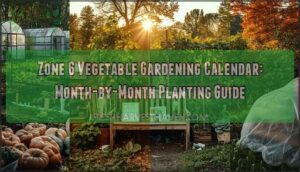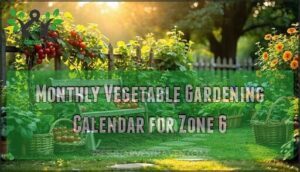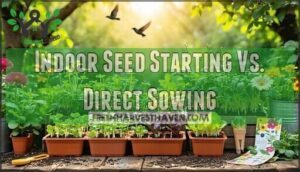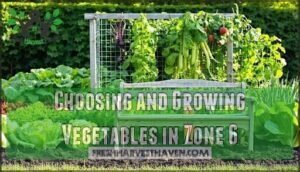This site is supported by our readers. We may earn a commission, at no cost to you, if you purchase through links.
 Your last frost date circles April 15 on the calendar—but that’s not the whole story. Zone 6 gardeners face a complex dance between unpredictable spring freezes, summer heat waves, and microclimates that can shift your planting window by weeks. One neighbor might harvest tomatoes in early July while you’re still waiting, all because of a south-facing wall or a low-lying frost pocket.
Your last frost date circles April 15 on the calendar—but that’s not the whole story. Zone 6 gardeners face a complex dance between unpredictable spring freezes, summer heat waves, and microclimates that can shift your planting window by weeks. One neighbor might harvest tomatoes in early July while you’re still waiting, all because of a south-facing wall or a low-lying frost pocket.
Success here demands more than knowing your zone—it requires understanding your specific patch of earth and timing every seed with precision. A well-planned vegetable gardening calendar for zone 6 transforms these challenges into opportunities, turning a 180-day growing season into months of continuous harvests.
Master the rhythm of your frost dates, soil temperatures, and succession planting windows, and you’ll fill your basket from early spring through late fall.
Table Of Contents
- Key Takeaways
- Zone 6 Vegetable Gardening Basics
- Monthly Vegetable Gardening Calendar for Zone 6
- January–February: Winter Care and Indoor Seed Starting
- March: Early Spring Preparations and Pruning
- April: Direct Sowing and Cool-Season Crops
- May: Planting Warm-Season Vegetables
- June–August: Succession Planting and Summer Maintenance
- September–October: Fall Planting and Harvest
- November–December: Winterizing The Garden
- Planting Guide and Chart for Zone 6
- Choosing and Growing Vegetables in Zone 6
- Tips for Maximizing Harvest and Garden Success
- Frequently Asked Questions (FAQs)
- . Why Should You Start Seeds indoors?
- . Which Seeds Should You Start indoors?
- . When Should You Start Seeds indoors?
- . When Should You Transplant seedlings?
- Why Should You Start Seeds indoors?
- Which Seeds Should You Start indoors?
- When Should You Start Seeds indoors?
- When Should You Transplant seedlings?
- When to plant tomatoes in zone 6?
- What vegetables grow best in zone 6b?
- Conclusion
Key Takeaways
- Zone 6’s 180-day growing season runs from a mid-April last frost to mid-October first frost, but microclimates near walls, slopes, or low spots can shift your planting windows by 1-2 weeks in either direction.
- Success depends on matching crops to temperature windows—cool-season vegetables like lettuce and kale tolerate frost and go in 2-4 weeks before your last frost date, while warm-season crops like tomatoes and peppers need 60°F+ soil after all frost danger passes.
- Succession planting every two weeks and strategic use of row covers or cold frames can extend your harvest from early March through late November, adding up to 12 weeks of production beyond the standard frost-free period.
- Indoor seed starting 6-8 weeks before transplant dates, careful microclimate observation, and detailed record-keeping of planting dates and variety performance turn guesswork into a repeatable system that improves year after year.
Zone 6 Vegetable Gardening Basics
Before you plant your first seed in Zone 6, you’ll need to understand a few fundamentals that’ll set you up for success.
Getting the timing right, having the right tools on hand, and preparing your soil properly makes all the difference between a thriving garden and a frustrating season.
Let’s walk through the essentials you need to know before we get into the monthly planting calendar.
Understanding Zone 6 Climate and Frost Dates
Zone 6’s frost-free window gives you about 180 days to work with. Your last spring frost usually hits around April 15, while the first fall frost arrives near October 15. But here’s the thing—microclimates throw curveballs. A south-facing wall or low-lying pocket can shift your dates by weeks. Understanding frost and freeze patterns is essential for planning.
Key climate patterns to watch:
- Temperature fluctuations: Winter lows drop to -10°F to 0°F; summer peaks reach 85–87°F
- Frost risk windows: Zone 6a runs early-to-mid May through early-to-mid October
- Microclimate effects: Altitude, water proximity, and urban heat islands alter your hardiness zone’s behavior
- Weather extremes: Heavy precipitation events and shifting patterns require flexible planning
Essential Tools and Supplies for Zone 6
Once you know your frost dates, your next move is gathering the right gear to make those 180 days count. You’ll need a spading fork for turning clay-heavy soils, a hoe for weeding between rows, and quality gardening gloves that won’t shred after one season.
Grab soil testers to check pH before planting, pruning shears for maintenance tasks, and seed starting equipment—trays, heat mats, grow lights—for getting ahead indoors.
If you’re serious about extending your zone 6 growing window, consider row covers or greenhouse materials for frost protection.
Soil Preparation and Amendment Tips
Your tools won’t do much good if the ground beneath them is rock-hard clay or nutrient-starved sand—so before you plant a single seed, get your soil right.
Start with soil testing to check pH and nutrient levels, then work in compost or aged manure to build organic matter. Most vegetables prefer pH between 6.0 and 7.0, so adjust with lime or sulfur if needed.
Organic fertilizers feed both plants and beneficial microbes, turning average garden soil into a thriving foundation.
Garden Layout and Space Planning
A well-planned layout turns scattered plants into a productive system where everything has room to breathe, paths make sense, and you’re not trampling seedlings to reach the tomatoes. Start with garden mapping on paper, sketching your garden beds and noting sun exposure before you dig.
Smart space optimization includes:
- Vertical gardening for vining crops like beans and cucumbers
- Pathway design that’s wide enough for wheelbarrows (24–36 inches)
- Crop placement with tall plants on the north side
- Grouping plant varieties by watering needs
- Allowing 18–24 inches between garden beds for maintenance access
Monthly Vegetable Gardening Calendar for Zone 6
Your Zone 6 garden has a rhythm, and timing is everything. This month-by-month calendar walks you through the entire growing year—what to plant, when to start seeds, and how to keep your garden productive from winter through fall.
Let’s break down each season so you know exactly what to do and when.
January–February: Winter Care and Indoor Seed Starting
While snow blankets your Zone 6 garden, the growing season is already beginning—right on your windowsill. Late January’s the sweet spot for indoor seed starting—think tomatoes, peppers, and eggplants that need 8-10 weeks before transplanting. Indoor lighting matters—seedlings need 14-16 hours daily.
Set up your cold frames now for winter garden preparation, and don’t skip seed selection: choose varieties suited to Zone 6’s short season.
If you’re feeling ambitious, winter pruning of perennial herbs keeps them vigorous for spring.
March: Early Spring Preparations and Pruning
March is when Zone 6 gardeners roll up their sleeves and get their hands dirty—because the moment that soil thaws enough to work, you’ve got a narrow window to prep beds, prune dormant plants, and start hardening off those indoor seedlings before the April rush hits. Soil testing comes first—pH and nutrient levels tell you exactly what amendments you’ll need.
Tackle garden cleanup by removing winter debris, and sharpen your tools now while you’re thinking about it. Pruning techniques matter for asparagus and perennial herbs; cut back dead growth to encourage strong shoots.
Watch forecasts closely—frost protection may still be necessary for tender transplants you’re hardening off outdoors.
April: Direct Sowing and Cool-Season Crops
By mid-April, your Zone 6 garden can tolerate a surprising number of crops. Lettuce, spinach, peas, and radishes will shrug off light frosts and actually prefer cool soil, so don’t wait for picture-perfect weather.
Direct sow these cool-season crops as soon as you can work the ground. Choose seed varieties bred for spring production, and follow your planting calendar closely—April’s the sweet spot for cool weather crops before heat arrives.
May: Planting Warm-Season Vegetables
Once the last frost date passes—usually around May 10–15 in Zone 6—you can finally plant tomatoes, peppers, squash, and everything else that sulks in chilly soil. Wait until soil temperature hits at least 60°F before transplanting warm-season crops; cold ground stunts roots and invites disease.
Use your planting calendar to stagger planting dates through late May, giving you room for smart crop rotation and a garden layout that won’t leave bare patches come summer.
June–August: Succession Planting and Summer Maintenance
Summer heat kicks in, but your garden’s work isn’t done—June through August is when succession planting keeps your harvest rolling and smart maintenance separates thriving beds from crispy, bug-riddled disasters. Here’s your Zone 6 summer maintenance roadmap:
- Sow quick-maturing warm season crops like bush beans and summer squash every two weeks for continuous harvests
- Monitor soil moisture daily—mulch heavily and water deeply to combat heat tolerance issues
- Practice summer pruning and scout for garden pests weekly, rotating crops to break disease cycles
Your gardening calendar should include regular weeding and staking tasks to keep plants productive through August’s swelter.
September–October: Fall Planting and Harvest
As September’s cooler nights roll in, you’ve got a golden window to plant a whole second wave of crops and squeeze every last tomato, pepper, and winter green out of your Zone 6 garden before frost shuts things down.
Here’s your Fall Crop Selection and harvest strategy:
| Task | Timing | Action |
|---|---|---|
| Direct sow | Early September | Spinach, lettuce, radishes, turnips |
| Transplant | Mid-September | Kale, collards, bok choy |
| Frost protection | Late September–October | Row covers, cloches for tender crops |
| Harvest | Before first fall frost | Tomatoes, peppers, eggplant, squash |
| Soil prep | October | Add compost, plant garlic and overwintering onions |
Your gardening calendar should prioritize extending harvest with succession plantings while monitoring your local fall frost date—usually mid-October in Zone 6. Protect tender crops with frost blankets, pull summer annuals after hard frost, and focus on soil health by working in organic matter for spring. Plant garlic cloves and overwintering crops like spinach for early spring greens, turning autumn cleanup into next season’s head start.
November–December: Winterizing The Garden
When frost has finally claimed the last of your fall greens and your garden beds sit bare, November and December are all about tucking your Zone 6 plot in for winter—not abandoning it, but setting it up to wake strong come spring.
Here’s your winter garden prep checklist:
- Spread 2–3 inches of mulch or shredded leaves over beds for soil insulation and weed suppression
- Clean up disease-prone plant debris, but leave healthy stalks for beneficial insects
- Protect perennial herbs and overwintering crops with row covers or cold frames
- Oil and sharpen tools, drain hoses, and organize supplies for garden maintenance downtime
Your frost protection efforts now pay dividends in soil health and early spring readiness.
Planting Guide and Chart for Zone 6
Knowing when to plant isn’t just about following dates on a calendar—it’s about understanding which vegetables thrive in cool weather versus those that need serious heat. The right timing means the difference between a bumper crop and a disappointing harvest.
Let’s break down the key planting windows, starting methods, and how to fine-tune your schedule for your specific corner of Zone 6.
Cool-Season Vs. Warm-Season Vegetable Timelines
Knowing which vegetables thrive in the chill of spring versus the heat of summer is your first step toward a garden that produces from April straight through October. Cool season crops like lettuce, kale, and broccoli tolerate frost and prefer temperatures below 70°F—plant them around your last frost date. Warm season crops such as tomatoes, peppers, and eggplant need soil above 60°F and go in after all frost danger passes.
| Cool Season Crops | Warm Season Crops |
|---|---|
| Lettuce, spinach, kale | Tomatoes, peppers, eggplant |
| Tolerate light frost | Require 60°F+ soil |
| Plant 2-4 weeks before last frost | Plant after last frost date |
| Harvest spring and fall | Harvest mid-summer through fall |
| Bolt in heat above 75°F | Thrive in 70-85°F temperatures |
Understanding these seasonal transitions helps you time your planting schedule perfectly and build effective crop rotation strategies for continuous harvests.
Indoor Seed Starting Vs. Direct Sowing
Deciding whether to start seeds indoors under grow lights or sow them straight into garden soil depends on each vegetable’s tolerance for cold and how much time it needs to mature. Tomatoes, peppers, and eggplant need indoor seed starting 6–8 weeks early to reach transplant size, while carrots, beets, and green beans germinate fast enough for direct sowing once soil temperature hits 50°F.
Check germination rates and sowing depths on seed packets—light requirements vary, and proper depth ensures strong seedlings.
| Method | Best Vegetables | Timing for Zone 6 |
|---|---|---|
| Indoor Seed Starting | Tomatoes, peppers, eggplant, broccoli | 6–8 weeks before last frost |
| Direct Sowing | Carrots, beets, green beans, lettuce | After soil reaches 50°F+ |
| Either Method | Cucumbers, squash, kale | 2–4 weeks before/after last frost |
Average Planting and Harvest Dates by Vegetable
Your planting dates and harvest dates drive every decision in Zone 6 gardening tips. Understanding the zone 6 planting chart is essential for a successful garden.
Tomatoes need indoor starts from March 15–April 15, transplant May 15–30, then harvest late July through September—70 to 85 days to harvest after transplanting. Lettuce tolerates the average last frost date better: sow April 1–June 15, harvest 45–65 days later. Tracking harvest timing and vegetable maturation windows helps you plan crop rotation and seasonal varieties for gardening schedules that keep production steady.
| Vegetable | Planting Window | Harvest Window |
|---|---|---|
| Tomatoes | Indoor: Mar 15–Apr 15; Transplant: May 15–30 | Late July–September |
| Cucumbers | Indoor/Direct: May 10–30 | Late July–Early September |
| Carrots | Direct: Mar 25–Apr 10 | July–September |
| Green Beans | Direct: May 10–20 | Late June–August |
Adjusting Schedules for Microclimates
Your garden doesn’t live in an average—it lives in the specific shelter of a south-facing fence, the shadow of a shed, or the frost pocket at the bottom of a slope. Microclimate analysis reveals climate variations that shift your frost date by weeks.
Check soil temperature before planting—warm spots near walls let you start earlier, while shaded areas need frost protection strategies.
| Microclimate Type | Frost Date Adjustment | Regional Adaptation Strategy |
|---|---|---|
| South-Facing Wall | 1–2 weeks earlier | Start warm-season crops sooner |
| Low-Lying Area | 1–2 weeks later | Add frost protection; delay planting |
| Hilltop/Slope | On schedule to 1 week earlier | Follow standard Zone 6 gardening tips |
Adapt your planting guide for Zone 6 by observing frost dates and gardening by zone within your specific yard conditions.
Choosing and Growing Vegetables in Zone 6
Zone 6 offers a wide range of options regarding what you can grow—from quick-maturing greens to hardy root crops that store all winter. The key is matching vegetables to your garden setup and deciding whether you want plants that come back every year or ones you’ll replant each season.
Let’s look at what thrives here and how to make the most of your space.
Best Leafy Greens, Roots, and Pods for Zone 6
Zone 6 gives you the sweet spot for growing a diverse lineup of vegetables, and knowing which leafy greens, roots, and pods thrive here means you’ll be harvesting from spring through late fall.
For leafy greens, you can’t beat arugula, kale, and leaf lettuce—they tolerate frost dates like champs and pack serious vegetable nutrition.
Root vegetables like carrots, beets, and parsnips anchor your Zone 6 gardening plan with reliable yields.
Pod selection matters too: green beans and peas deliver consistently when you time them right with your planting guide.
Perennial Vs. Annual Vegetables
Most gardeners don’t realize that choosing between perennials and annuals isn’t just about replanting—it’s about shaping how much work you’ll do for years to come. Perennial benefits include:
- Asparagus returns for 15+ years with minimal effort
- Artichokes establish deep roots and survive Zone 6 winters
- Rhubarb thrives without yearly seed starting
- Chives self-propagate and fill gaps naturally
Annual crops like tomatoes and beans demand replanting but give you plant diversity and flexibility to rotate varieties each season in your vegetable garden.
Companion Planting Strategies
Pairing the right plants together works like building a neighborhood where good neighbors help each other thrive. Some repel pests, others fix nitrogen in the soil, and a few just make better use of vertical space.
Try planting tomatoes with basil to deter aphids, or let beans climb your corn stalks while squash shades out weeds below. This classic trio improves soil health and maximizes your vegetable garden’s productivity without extra inputs.
Growing Vegetables in Containers
Containers turn almost any sunny spot—a balcony, patio, or front step—into productive growing space when you don’t have room for a traditional in-ground garden.
Choose pots at least 12 inches deep with drainage holes, fill them with quality soil mixtures formulated for container vegetable gardening, and transplant seedlings of compact varieties like cherry tomatoes, peppers, or lettuce.
Vertical growing structures optimize small space farming by letting beans or cucumbers climb upward instead of sprawling outward.
Tips for Maximizing Harvest and Garden Success
Getting plants in the ground is just the beginning—the real magic happens when you protect what you’ve grown and keep your garden producing all season long.
These five strategies will help you stay ahead of problems, extend your harvest window, and set yourself up for even better results next year.
Let’s walk through the techniques that turn a decent Zone 6 garden into an abundant one.
Pest and Disease Prevention in Zone 6
Think of pest and disease control as your garden’s insurance policy—small investments now save the harvest later.
In Zone 6, squash bugs and armyworms hit hardest within three weeks of planting, so weekly inspections are non-negotiable.
Integrated Pest Management combines physical barriers like bug netting, beneficial companions such as sweet alyssum for predatory wasps, and organic methods including neem oil for leaf damage.
Pair these biological strategies with cultural practices—raised beds for drainage, crop rotation, and drip irrigation—to create a pest watch guide that keeps problems manageable without harsh chemicals.
Succession Planting and Crop Rotation
Once you’ve tackled the pests, rotation and replanting become your rhythm for keeping the beds productive all season long. Succession planting—sowing lettuce every two weeks or replacing spring peas with summer beans—keeps harvests rolling.
Crop rotation breaks pest cycles: follow heavy feeders like tomatoes with nitrogen-fixing legumes, then root crops.
Your planting schedule and gardening calendar turn crop planning into a dance of soil management and harvest strategies.
Extending The Growing Season
Row covers and cold frames aren’t just backup plans—they’re how you push beyond Zone 6’s standard May 1 last frost date and November 1 first frost date. High tunnels can stretch production from March through November, adding four to six weeks on each end. That means spinach in April and lettuce in December.
- Low tunnels raise soil temps by 2.5°C, boosting carrot and beet yields up to 30%
- Row covers inside high tunnels increase harvest by 47% compared to open ground
- Double-layer covers protect brassicas through nights below -3°C
- Portable heaters keep cold-sensitive crops alive when soil dips toward 5°C
Track soil temperature with a logger and you’ll cut crop loss by a quarter—precision beats guesswork when frost management and greenhouse techniques become part of your routine.
Harvesting, Storing, and Preserving Vegetables
Picking at the right time matters just as much as growing well—harvest too early and flavors fall flat, wait too long and you’re left with tough greens or woody roots that won’t keep. Cool morning harvesting locks in sweetness and crunch.
For maximizing harvest through winter, root cellars hold beets and carrots at 0–4°C for months. Freezing methods work best for beans and peas, while canning techniques preserve tomatoes and pickling recipes transform cucumbers into shelf-stable staples.
Record Keeping and Garden Planning for Next Season
Tracking what thrives and what flops turns your Zone 6 garden from a yearly gamble into a predictable system. Jot down planting dates, variety names, pest problems, and harvest weights while the season’s fresh in your mind, then use those notes to fine-tune next year’s plan.
Garden journaling builds a blueprint: map bed locations for crop rotation, track yield patterns through seasonal review, and note microclimates that shifted timing.
Those garden notes become your most valuable tool for vegetable garden planning—you’ll stop guessing and start growing with confidence.
Frequently Asked Questions (FAQs)
. Why Should You Start Seeds indoors?
Starting seeds indoors gives you a jumpstart on the growing season, boosting germination rates and letting you choose varieties from seed catalogs that aren’t available as transplants.
Indoor lighting and controlled soil temperature create ideal conditions for seed starting.
. Which Seeds Should You Start indoors?
Tomatoes, peppers, and eggplants need a head start indoors—their long growing seasons demand it.
Cool-season crops like lettuce and peas? Sow seeds indoors only if you’re chasing an ultra-early harvest, though direct sowing works fine.
. When Should You Start Seeds indoors?
Count backward from your average last frost date—usually 6–10 weeks for most vegetables.
Check seed packets for germination rates and indoor lighting needs, then mark planting dates on your calendar when placing seed orders.
. When Should You Transplant seedlings?
Timing is everything—don’t jump the gun! Transplant your seedlings outdoors after hardening off and when soil temperatures warm enough for your specific crops.
For seedling selection, choose sturdy transplants with healthy roots, ensuring proper soil acclimation through gradual exposure.
Why Should You Start Seeds indoors?
You’ll get stronger seedlings with better root systems when you control soil temperature and indoor lighting.
Early germination rates improve dramatically, giving warm-season crops like tomatoes the head start they need in Zone 6’s shorter growing season.
Which Seeds Should You Start indoors?
Sow what you’ll grow! Focus on slow-maturing warm-season crops using quality starter mix: tomatoes, peppers, eggplant, and broccoli benefit most from indoor sowing in Zone
Check seed catalogs for days-to-maturity and adjust your climate control accordingly.
When Should You Start Seeds indoors?
Mark your last frost date on the calendar, then count back 6–8 weeks for tomatoes and peppers, 8–10 weeks for slower crops like onions.
Indoor lighting and proper soil temperature guarantee strong germination rates and healthy transplants.
When Should You Transplant seedlings?
Your seedlings are ready to transplant after hardening off for 7–10 days and when nighttime temperatures stay above 50°F for warm-season crops.
For zone 6, that’s usually mid-May after your last frost date passes.
When to plant tomatoes in zone 6?
In Zone 6, you’ll transplant tomatoes outdoors after your last frost date—usually mid-May.
Start seeds indoors 6-8 weeks earlier, around late March.
Wait until soil temperature reaches 60°F for best root development and frost protection.
What vegetables grow best in zone 6b?
In Zone 6, cool-season crops like kale, broccoli, and carrots thrive alongside warm-season favorites such as tomatoes, peppers, and beans.
Regional varieties adapted to your frost dates and soil preparation will boost your vegetable gardening success throughout the growing season.
Conclusion
Your grandmother’s almanac got it right: patience and observation trump rigid dates every time. A thoughtful vegetable gardening calendar for zone 6 isn’t a mandate—it’s a living framework that bends with your soil’s quirks, your backyard’s microclimates, and those late-April surprises.
Track what works, adjust what doesn’t, and remember that every frost-nipped seedling teaches you something valuable. Your garden rewards flexibility, not flawlessness. Keep planting, keep learning, and those harvest baskets will overflow season after season.










